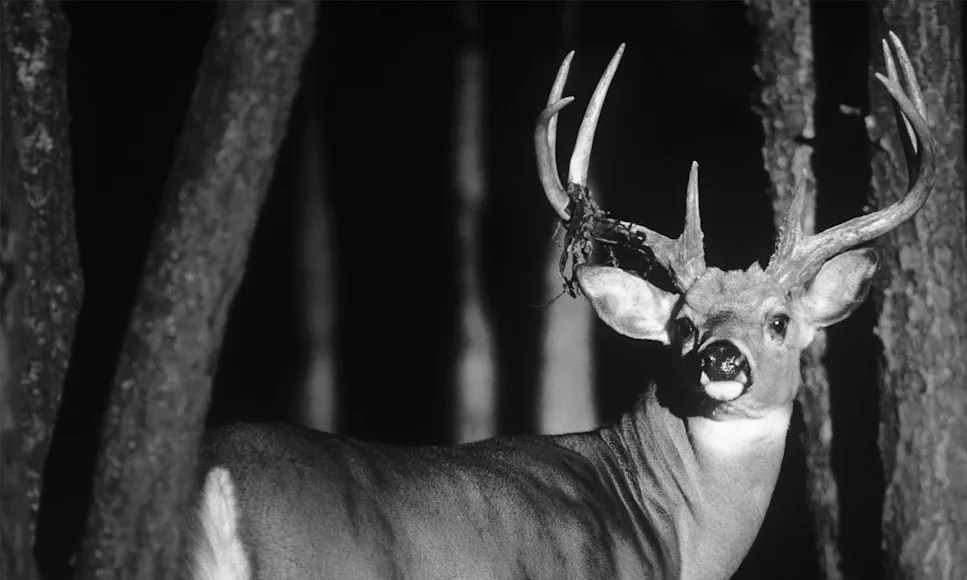The trail camera may be the most impactful innovation for whitetail hunters in my lifetime. Particularly, the cellular trail camera. Real-time intel about a big buck’s secret movements has, on more than one occasion, led to a filled tag for me. But more and more hunters I talk to are shying away from using cellular cameras, and all for the same reason: They suspect that mature bucks are avoiding them.
One experienced hunter I recently did consultation work for swore that mature buck traffic ground to a halt when he swapped a traditional camera for a cellular model at a particular crossing. And you'll find plenty of hunters making similar claims on social media. But is there any science to support that big bucks can somehow detect, and therefore will avoid, cellular trail cameras over their non-cellular counterparts? The answer, in a word, is no. But let's take a closer look.
Cell Cams and Big Bucks

There are two key variables in this claim that need to be defined: the type of camera and the type of buck reacting to them. The main difference between the two basic types of trail cameras is how data is obtained. Conventional cameras require manual retrieval of data via an SD card, while cellular cameras transmit data via radio signal to a tower and then to the internet to be accessed by a computer or phone. Yes, there is some variance of shape and size, but the key is that one emits a radio signal and one does not.
The two deer in question are mature and immature bucks. Doug Roberts, a.k.a. The Deer Professor has owned and run Conquest Deer Farms for over thirty years, living with dozens of mature bucks through their lifetimes. What he's observed over and over is that young bucks somewhat tolerate human intrusion and are very predictable in their movements, while mature bucks notice every detail of their environment, are intolerant of any changes, and move in unpredictable ways. My hunting experience on pressured public land in Michigan has taught me something similar—that after their third birthday, most bucks have had so many run-ins with hunters that they are extremely sensitive to any trace of a human. The bottom line, as most hunters have seen for themselves, is that mature bucks are warier creatures to the core. This could explain why young bucks might ignore cameras while older bucks avoiding them once noticed, but it in no way explains how big bucks could possibly detect the radio signal from the cellular kind specifically.
What the Science Tells Us
Frequencies for particular cellular camera transmissions vary, but they generally fall in the MegaHertz range (MHz or millions of hertz). For example, SpyPoint Flex series cameras transmit in a range from 800 to 2,100MHz. And the only two whitetail sensory organs known to detect waves are their ears and eyes.
A study done by Henry Heffner of the University of Toledo found deer hearing to range from roughly 32Hz to a max of 64,000Hz (or 64 KiloHertz). Cellular camera transmission are three orders of magnitude, or 1,000 times, higher in frequency than what a deer can hear. To put this in perspective, humans can hear up to 20,000 Hz, and dog whistles are around 40,000 Hz—only 2 times higher—and we can’t hear them.

Various whitetail vision studies place deer vision between the upper red frequencies and well into ultraviolet (falling in the TeraHertz and PetaHertz range). Radio waves from a cell cam are more than six orders of magnitude, or 1 million times, greater than that. To suggest big bucks could see radio waves would liken us to seeing microwaves or X-rays. So as wary as a big old buck may be, their sensory organs cannot come close to detecting the waves transmitted from a cellular trail camera.
So, What is Going On with Big Buck and Cell Cams?
The real reason for detection isn't a sixth sense or an undiscovered sensory organ bucks develop when they mature. If big bucks seem to be avoiding your cell cams more than traditional cams, that's probably nothing more than coincidence. That they are detecting a camera of either type, however—much as we hate to admit it—is most likely human error. Since mature bucks have a zero tolerance policy for any sign of a human, an improperly placed camera throws a huge red flag. Any scent left in the area, any click from a noisy shutter, or an obtrusive “thing” hanging off a tree, is sure to get a mature buck's attention. That said, there are several ways to make that cell cam less detectable by the known and very acute senses of big whitetails. Here are six.
1. Do a Trial Run
Most hunters don't test their cameras before placing them. Specifically, you want to test for maximum trigger range both day and night, as well as audible noise. If you’ve ever gotten pictures of bucks looking directly at your camera, don’t automatically blame the flash, because it’s probably the sound of the shutter. Try a new brand or model until you find a quieter version.
2. Adopt a No Contact Policy
I always wear rubber boots and gloves when placing or checking cameras. I'll even use hip boots for areas with high grass and ground brush. I use a backpack that's reserved solely for camera gear, and I keep a pile of rubber gloves inside, changing them for each camera set. I also use ozone to sterilize the bag after every trip, and I treat the camera strap and wipe the camera clean with scent-free wipes before placing it.
3. Use The Head High Rule
Hanging cameras about 6 to 8 feet off the ground works well for me. We’ve all seen guys on TV hanging them waist high and 5 feet from a salt block, but if you think deer are avoiding your cam, it only makes sense to make them less obvious—especially in highly pressured areas. Head height is typically out of the direct view of deer and doesn’t make for too steep a picture angle. This also makes it a little harder or deer to directly sniff your camera.
4. Get a Good Angle
Avoid placing camera in a buck's direct line of sight on trails. I’ve found that running cameras off to the side at a 45-degree angle minimizes detection while maximizing trigger rates. For surveilling scrapes, mineral licks, or feed stations, consider placing cameras in such a way that deer are less apt to see it. Since the animals have a 60-degree blind spot behind them, hanging cameras that are behind a whitetail’s most likely forward facing position gives you a much better chance at complete concealment.
5. Back Off a Bit
Camera manuals detail how far the detection and flash ranges are. Once verified in your test, place cameras in the farthest-away position that will still take good pictures, day and night. Closeups are not necessary, and more distance between a camera and a good buck means less risk of detection. This is true for both visual and audible detection due to the sound of the shutter. The far end of the flash range is your safest bet.
6. Hang Cams Like Your Life Depends on It
I once came home and noticed a cigarette butt in my kitchen, and I don’t smoke. My fight or flight response was immediate because in that moment I realized my home had been broken into and I was in danger. A big buck is no different. Reversing roles helps bring perspective on how covert you must be with cameras. So take great effort to conceal it with branches, leaves, or any means possible. Because if a smart buck finds it, his response will be immediate too. Old bucks are wary animals, but aren’t equipped with radio antennas. Using proper caution with cellular cameras can give an edge to any hunter looking to catch up to such a trophy whitetail.


